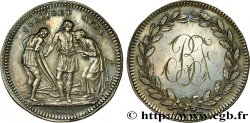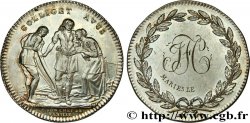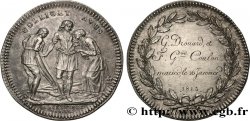fjt_072929 - NORMANDY (GENTRY AND TOWNS OF...) Jeton Ar 30, Société des cœurs réunis de Dieppe (franc-maçonnerie) 1784
Not available.
Item sold on our e-shop
Price : 65.00 €
Item sold on our e-shop
Price : 65.00 €
Type : Jeton Ar 30, Société des cœurs réunis de Dieppe (franc-maçonnerie)
Date: 1784
Metal : silver
Diameter : 30 mm
Orientation dies : 6 h.
Edge : cannelée
Rarity : R1
Coments on the condition:
Usure régulière et bon centrage. Très bel exemplaire
Catalogue references :
Obverse
Obverse legend : JETTON DE LA SOCIÉTÉ DES CŒURS RÉUNIS DIEPPE 1784.
Obverse description : Légende en cinq lignes dans une couronne formée de deux branches de laurier nouées.
Reverse
Reverse legend : VIS UNITA FORTIOR ; À L'EXERGUE : E F U FORMANT UN CARTOUCHE.
Reverse description : Faisceau enrubanné.
Reverse translation : Le courage réuni est le plus fort.
Commentary
Exemplaire avec l’axe à six heures.
Même Labouret ne donne pas d’explication pour l’exergue du revers.
La franc-maçonnerie s’implante en France aux alentours du premier quart du XVIIIe s. sous l’influence d’aristocrates anglais. Initiatique, elle est fondée sur le rite hiramique, du nom d’Hiram de Tyr, personnage biblique, architecte du roi Salomon sur le chantier du Temple et qui a résisté à la torture sans livrer ses secrets. Hiram a aussi donné un point de départ du calendrier maçonnique commençant 4000 ans avant le calendrier chrétien. Les symboles servent de signes de reconnaissance entre les initiés, notamment des outils de constructeur de cathédrales (équerre, compas, niveau, maillet, etc.), des formes (triangle, étoile), des nombres (trois, cinq, sept) et des lettres.
Même Labouret ne donne pas d’explication pour l’exergue du revers.
La franc-maçonnerie s’implante en France aux alentours du premier quart du XVIIIe s. sous l’influence d’aristocrates anglais. Initiatique, elle est fondée sur le rite hiramique, du nom d’Hiram de Tyr, personnage biblique, architecte du roi Salomon sur le chantier du Temple et qui a résisté à la torture sans livrer ses secrets. Hiram a aussi donné un point de départ du calendrier maçonnique commençant 4000 ans avant le calendrier chrétien. Les symboles servent de signes de reconnaissance entre les initiés, notamment des outils de constructeur de cathédrales (équerre, compas, niveau, maillet, etc.), des formes (triangle, étoile), des nombres (trois, cinq, sept) et des lettres.








 Report a mistake
Report a mistake Print the page
Print the page Share my selection
Share my selection Ask a question
Ask a question Consign / sell
Consign / sell
 Full data
Full data



